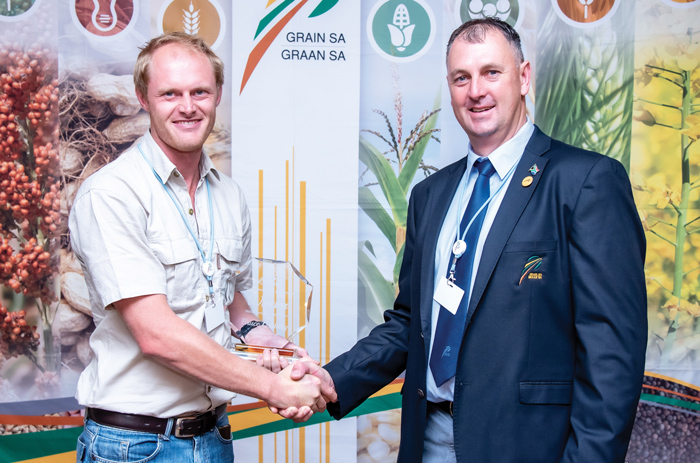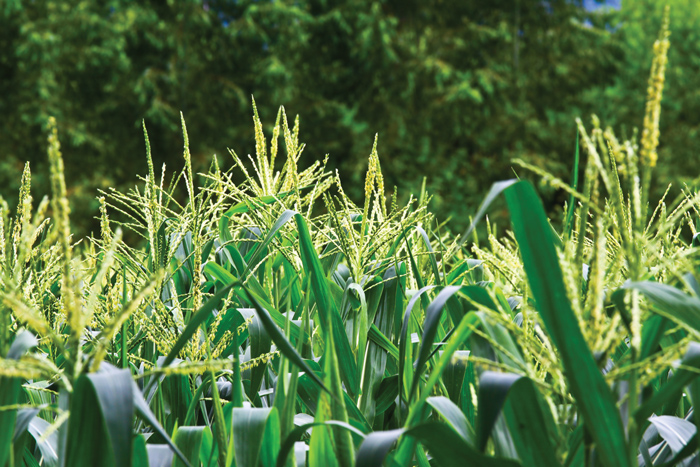First place in the maize category for the KwaZulu-Natal region in the Grow for Gold National Yield Competition, was awarded to Bruce Gibbings from Winterton, with a maize yield of 15,8 t/ha.
The Gibbings family’s main focus is crop farming. They plant about 33% maize, 33% soybeans and 33% sugar beans annually during the summer season. The winter crop consists of wheat and cover crops.
Choosing the right cultivars
This excellent yield was obtained using a Pioneer conventional hybrid, P 1197. The average yield for this particular hybrid on the 40 ha was about 14 t/ha. According to Bruce, it was the first year that they planted P 1197, thus only planting the 40 ha.
P 1197 is regarded as an ultra-quick grower and contains the stay-green characteristic, ensuring that the photosynthate is channelled to the pips for a longer period. The hybrid is conventional and forms part of the maize portfolio as they receive a premium for non-GMO. ‘We do not want to rely too much on glyphosate and tend to use different herbicides as it is better to have various modes of action on the weeds to make sure they do not develop resistance.’
Nothing out of the ordinary was done to the field he entered into the competition and he managed it in the same way as all the others. The only change they made was to spray more boron that season.
They also planted Pioneer P 1184 that averaged 13 t/ha and DKC 65-72 that averaged 13,5 t/ha. The total average maize yield on the farm for the past season was 13,5 t/ha. They received approximately 1 128 mm of precipitation for the season. According to Bruce, he managed to produce 14 kg grain/mm of rain if he calculates the grain produced per moisture available.

The blessing of early rains
He says that they received early rains that enabled them to plant much earlier than normal. ‘The early rain was a blessing. The land I entered into the competition actually got flooded. It is next to a river which broke its banks – some parts were submerged up to 1,5 m. Part of the land was damaged by debris, but fortunately, because we were able to plant a lot earlier, the maize was mature enough to handle the flooding.’
Bruce explains that because they are so close to the mountains, many cloudy days and a lack of sunlight and heat units are usually their biggest limiting factors. This past season yielded very little heat units. He is actually surprised at the great maize yield despite the lack of heat units and solar radiation.
Apart from the flooding, the other major challenge that he had to cope with during the past season was disease. ‘We had to spray four fungicides on some of the fields to control northern corn leaf blight. This extra disease pressure was mostly due to the high rainfall and consequent flooding with little heat units and not enough solar radiation.’
Disease is a huge challenge in the area where they farm and needs to be managed on an annual basis. ‘In our area we have to cope with rust, northern corn leaf blight and grey leaf spot. We have a preventative spraying programme in an attempt to control disease. We manage it with two applications of Nativo at the V6 and V10 stage. Then, after tasselling, we do a third application of Zantara that usually sees us through to maturity.’
Keeping an eye on costs
Bruce says that input costs have escalated during the past couple of years, resulting in his cost per hectare also increasing. His input costs were R1 128/ton or calculated differently, R14 100/ha for this particular hybrid and field. Seed was his most expensive input at R3 700/ha followed by urea at R3 500/ha.
Cost management remains important. ‘Looking at our direct input costs, I assess which products are giving the highest return on investment (ROI) year after year. Our aim is to reduce fixed costs as much as possible without hindering our farming logistics.’
Concerning cost in relation to profit, he says that sometimes reducing costs can decrease yield to the point of decreasing profit and vice versa. ‘You can also end up buying your yield. The relation between cost and profit is a balancing act every producer has to manage every year.’
Farming with nature
He believes that one can adjust one’s farming practices to increase profit. ‘I think there are other ways of farming to increase profit. The question I believe we should ask ourselves is: How sustainable is the use of all the sprays and other inputs and are we not potentially making our farming system completely dependent on fertilisers and pesticides? We are following what some producers are implementing in the United States where they are more focussed on soil and plant health. They use biological products, follow no-till practices and plant cover crops. They seem to still maintain their yields and have significantly reduced their fertiliser and pesticide applications. This is something that we are also trying to phase in.’
Bruce is part of a regenerative farming group that all specifically focus on building up the soil to support sustainable crop farming. Regenerative agriculture is when a producer follows farming principles that strive to regenerate soils by restoring the carbon, water and nutrient cycle. They practice no-till and plant cover crops in winter. He says when acidity problems are picked up in the fields, they will lime and then disc and plough the lime in to sort out the problem and return to no-till again as soon as possible.
A few tough challenges
Weeds remain a tough challenge. ‘We have been spraying glyphosate and Garlon to burn down Conyza before planting, but there are some years where we have to spray three or four times before planting to effectively control weeds before they come to seed. We find that planting cover crops really helps in smothering weeds and thus we have been able to reduce our burndown sprays to two applications in some instances.’
He adds that they usually do about three burndown sprays between the period of the previous harvest and just before planting. ‘It is far easier to control small weeds than large ones. We spray a pre-emergent herbicide at planting and another herbicide at about the V4 to V6 development stage of the maize.’
Regarding insect control, they include Karate at planting to control cutworm and then do another application at the V6 stage to control stalk borers when they are very young. Depending on the insect pressure they might include Coragen at V10 to control stalk borer or false army worm.
Theft is another challenge that they have to cope with. They employ temporary guards in different fields when the crops are at a vulnerable stage, especially the sugar beans. ‘We also have a private security company that has been very helpful in responding to call-outs in the middle of the night to help deal with poachers.’
They farm on sandy, alluvial Oakleaf soils and according to Bruce they are very privileged to have such fertile land. They grid sample their soils on a hectare basis and sub-soils on every four hectares. They then do variable rate corrections with lime, gypsum, KCl and MAP according to the soil analysis. The acid salts are close to 0 and they maintain the pH at around 6,5. They apply a total of 230 kg N, 36 kg P and 40 kg K per annum.
‘Boron management has been our most important contributor to yield. Adequate boron, especially before tasselling, is extremely important. We also use Bio-Forge for stress management and manganese for nutritional health.’
The family rent out some land to research institutions to do their trials and they also do their own strip trials from year to year.
Learning from others
Bruce says that his father, William Gibbings, is his greatest mentor and has played a huge role in his development as a producer. ‘I admire my dad very much and am grateful for his guidance and advice. He has taught me so much.’ Apart from his father, he often contacts Gary Wood and Bernic Botha from Farmers Agri Care. ‘They are my go-to contacts for crop protection. I really appreciate their help.’
His advice to young producers is to never stop learning. ‘Do not let self-pride control you. Absorb information, learn from your father and also learn to identify areas where you can adjust practices and make improvements. It is important to be flexible and adaptable. You can easily become set in your ways the older you become. One must be able to adapt to changing circumstances.’






























